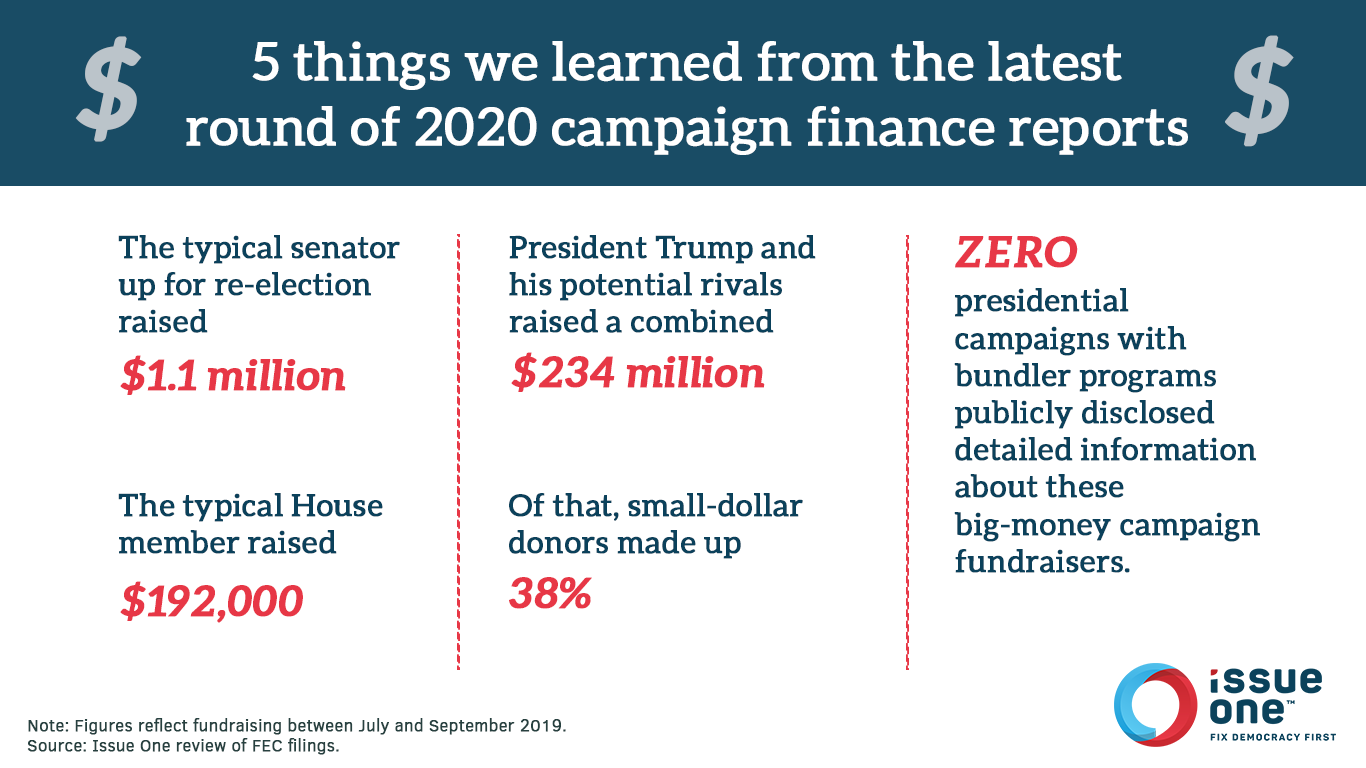Congressional and presidential candidates filed their latest campaign finance reports on Tuesday, detailing their fundraising and expenditures between July 1 and September 30.
Here are some key numbers to know, based on an Issue One review of these new filings.
$234 million
President Donald Trump and the Democratic and Republican candidates vying to replace him combined to raise about $234 million between July 1 and September 30, with Trump’s campaign alone raising about $42 million.
Democratic candidates combined to raise about $191 million. Billionaire environmental activist and former hedge fund manager Tom Steyer raised the most, about $50 million — with nearly $48 million coming from his own funds. Six other Democrats raised at least $10 million during the third quarter: Bernie Sanders ($25 million), Elizabeth Warren ($25 million), Pete Buttigieg ($19 million), Joe Biden ($16 million), Kamala Harris ($12 million), and Andrew Yang ($10 million).
The three Republicans running against Trump in the GOP primary — Mark Sanford, Joe Walsh, and Bill Weld — raised about $740,000 combined during the third quarter.
38%
About 38% of the $234 million raised by President Donald Trump and his challengers during the third quarter came from small-dollar donors contributing $200 or less. About 34% of the money Trump raised — and about 39% of the money collected by Democratic presidential candidates — came from small-dollar donors giving $200 or less. That amounts to a total of $88 million raised from small-dollar donors during the third quarter — $73.5 million by the Democratic presidential candidates and $14.5 million by the Republican presidential candidates.
Such grassroots donors are important because they are more likely to be invested in the political process, to volunteer during the election, and to vote on Election Day, and they can be tapped by candidates to donate over and over again throughout the campaign.
Zero
To date, no presidential campaigns have publicly disclosed the information requested about their bundlers by Issue One and a coalition of 15 other organizations from across the ideological spectrum.
A number of candidates — including Elizabeth Warren, Bernie Sanders, Tom Steyer, and Andrew Yang — have said they do not have official bundler programs.
Joe Biden allows reporters into his fundraisers but his campaign has not released a list of his bundlers. Kamala Harris has published a list of more than 100 bundlers who have raised at least $25,000 for her campaign. And Pete Buttigieg released a list of about two dozen bundlers in April — but has not updated it since.
Meanwhile, President Donald Trump — who has reportedly recruited more than 400 bundlers — has not publicly disclosed any information about them, beyond the information he must report by law about the registered lobbyists who are raising money for his re-election campaign.
Issue One and its coalition partners urged all presidential candidates to regularly disclose the aggregate amount each bundler has raised for their campaigns. The coalition also called on presidential candidates to provide the name, city, state, and ZIP code of each bundler, as well as each bundler’s employer and occupation — information that candidates must already publicly disclose for large donors.
$1.1 million
The median amount of money raised during the third quarter by a sitting senator running for re-election in 2020 was $1.1 million — the equivalent of about $12,200 per day. That’s more than eight times as much money as their colleagues who are not facing re-election next year raised: The median amount that senators up for re-election in 2022 and 2024 collected was $139,000 — about $1,500 per day. Combined, all incumbent senators raised about $54 million from individuals, political action committees, and other sources between July and September.
That’s roughly on par with the second quarter, when all senators combined to raise about $56 million and the typical senator running for re-election in 2020 also raised $1.1 million. It’s also an increase from the first quarter, when all senators combined to raise $46 million and the typical senator running for re-election in 2020 raised about $936,000.
$192,000
The median amount of money raised during the third quarter by a member of the House of Representatives was approximately $192,000 — or about $2,100 per day. Meanwhile, the median amount raised by House freshmen was about $383,000 — or about $4,200 per day. The typical incumbent running for re-election in a race rated as a toss-up by the Cook Political Report raised roughly $529,000 — about $5,750 per day. Combined, all House members raised about $119 million from individuals, political action committees, and other sources between July and September.
That’s roughly on par with the second quarter, when all House members combined to raise about $126 million, and it’s up from the first quarter of the year, when all House members combined to raise $104 million.
Amisa Ratliff contributed to this report.








